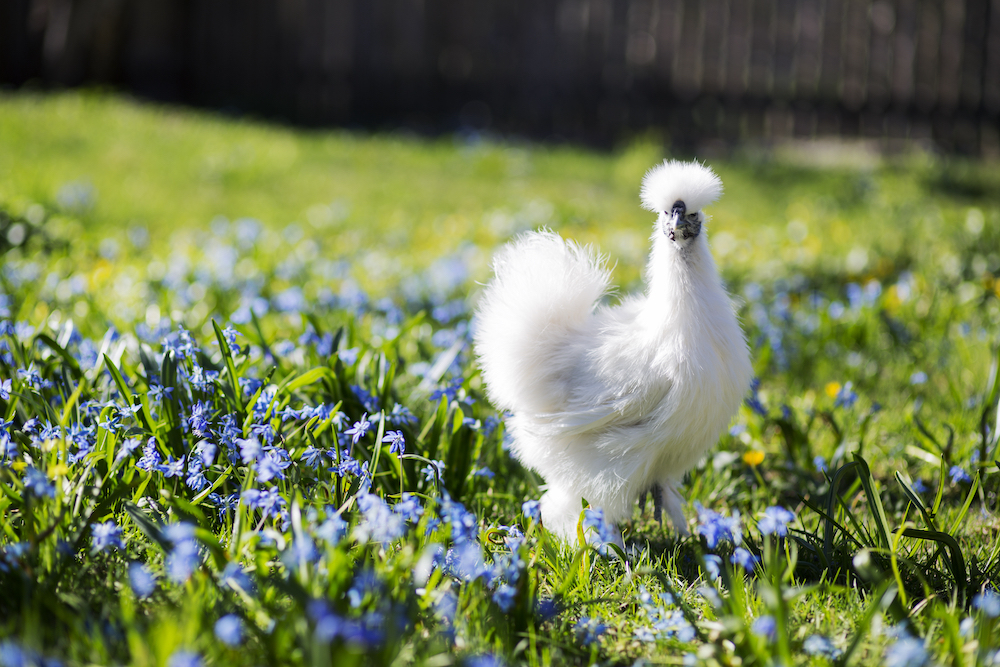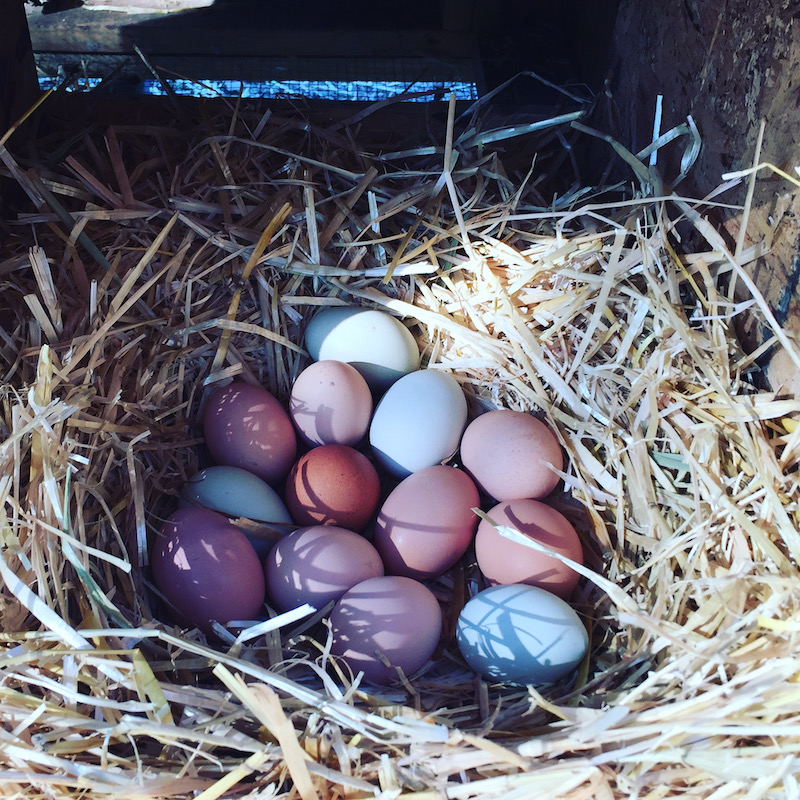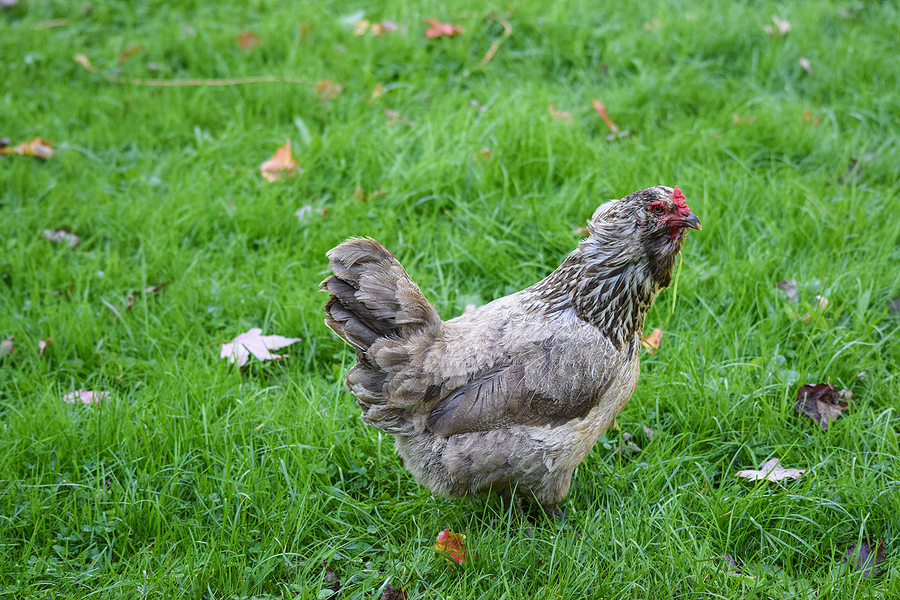Last Updated on February 19, 2024 by AwesomeChickens
The Leghorn chicken, a breed well-renowned for their exceptional egg-laying abilities, originated in Italy and were later refined in the United States and Britain. These birds are characterized by their lightweight frame, striking white plumage—although they do come in other colors—and their notable upright tail. The name “Leghorn” is derived from the Italian port city of Livorno, from which the first birds of this kind were believed to be exported to the United States around the 1820s.
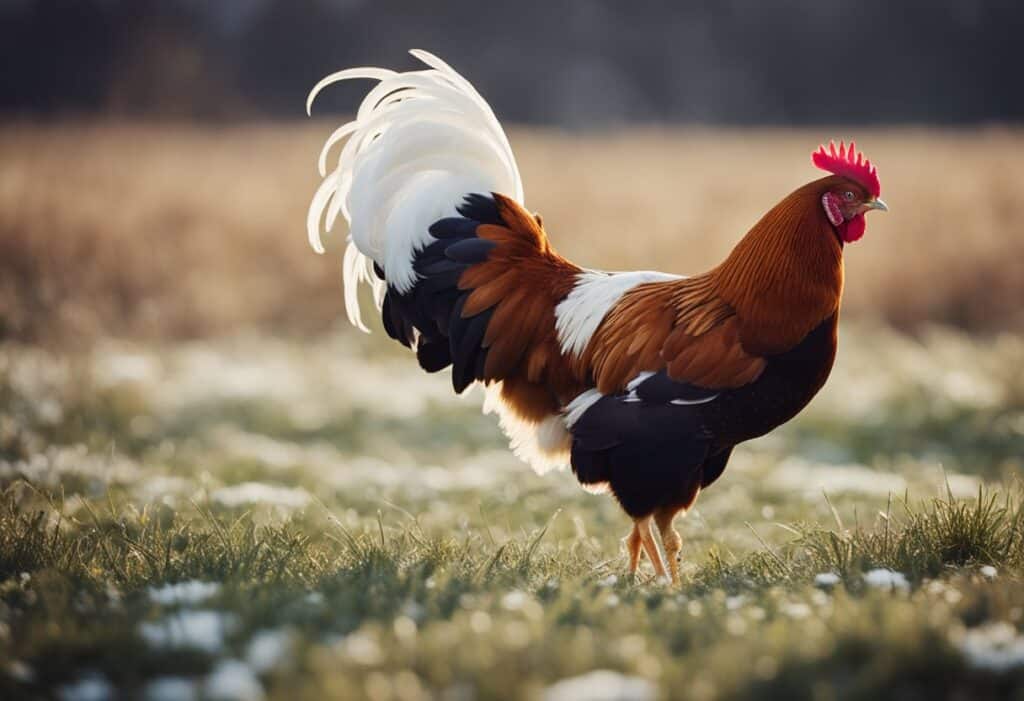
Since their introduction, the Leghorn chicken has become a staple in the egg production industry due to their prolific output and the high quality of their large white eggs. They are a hardy breed, known not only for their productivity but also for their adaptability to a wide range of climates. This resilience has contributed to their widespread popularity across the globe, where they continue to play a significant role in commercial poultry farming.
Their origin story is indeed a testament to the breed’s versatility and enduring appeal. From the farms of Tuscany to the vast agricultural expanses of the American heartland, Leghorn chickens have thrived and have been selectively bred over the generations to emphasize their most desirable traits. This careful selection has resulted in a breed that is not just an economic asset but also a fascinating subject for those interested in poultry genetics and breed development.
Table of Contents
History and Origin
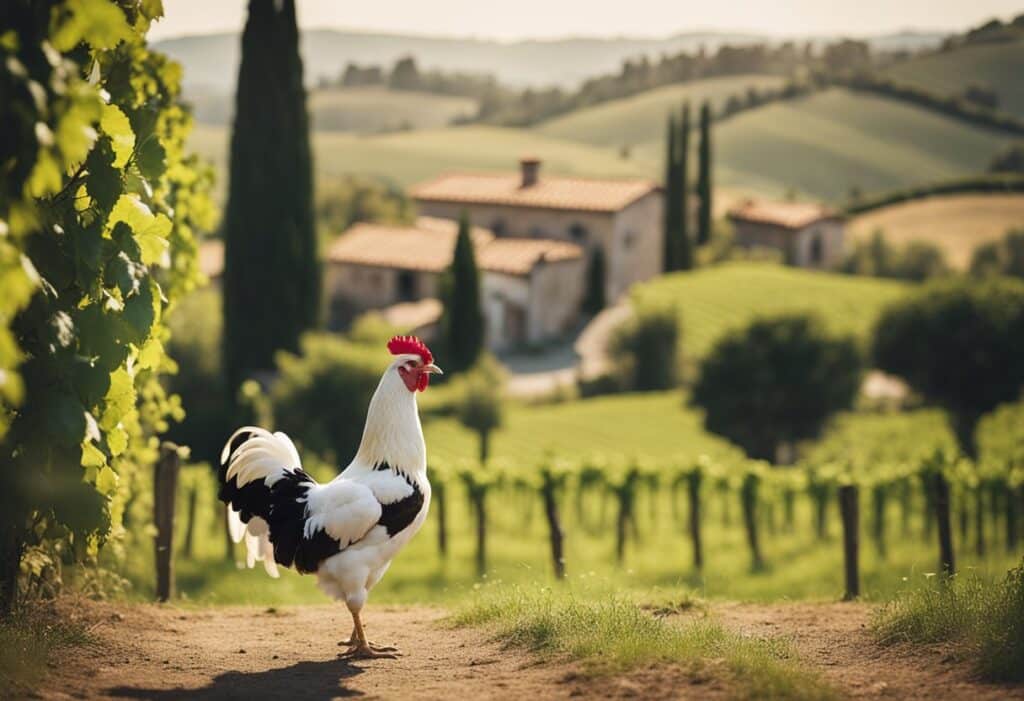
The Leghorn chicken, renowned for its prolific egg-laying abilities, has a storied history that spans from the shores of Italy to the farms of America. Its development has been influenced by both Italian and American breeders, leaving a lasting impact on poultry farming.
Origins in Italy
The Leghorn chicken originated in the port city of Livorno, in the Tuscany region of Italy. They were first exported to North America in the early 1800s. These Italian birds were valued for their impressive egg production and were known as “Livornese” in Italy.
Development in America
In the United States, the breed underwent significant development to enhance its egg-laying capacity and adapt to local conditions. American breeders focused on improving the size and productivity of the Leghorn, and by the late 19th century, it was recognized as a distinct breed by the American Poultry Association. Americans appreciated not only the Leghorn’s egg-producing abilities but also their hardiness and adaptability to various climates.
Breed Characteristics
The Leghorn chicken is renowned for its productivity and distinctive physical traits. This section provides a detailed look at the breed’s physical appearance and behavior, specifically focusing on variations in size, comb type, and general temperament.
Physical Appearance
Size: The Leghorn chicken comes in both standard and bantam sizes. The standard variety typically weighs 2.5 to 3.6 kg for males and 2.0 to 2.5 kg for females, while bantam Leghorns are considerably smaller.
Comb Type: There are primarily two types of combs seen in Leghorns: the single comb and the rose comb. The single comb is large and upright with evenly spaced points, whereas the rose comb is broader, flatter, and covered with small rounded points.
- Feathers and Plumage: Leghorns possess a tight-fitting plumage, which contributes to their sleek appearance. Their feathers are predominantly white, especially in the White Leghorn variety, which is the most commonly recognized color.
- Color Varieties: While the White Leghorn is widely known, the breed also comes in a range of other color varieties, each with their own unique feather patterns and colorations.
Behavior and Temperament
Leghorn chickens are known for their active and alert disposition. They are highly capable foragers and do well in free-range conditions where they can explore and search for food.
- Social Behavior: These birds can be somewhat standoffish and are not as broody as some other breeds, which can be an advantage for egg production.
- Productivity: Leghorns have earned a reputation for being excellent layers, often producing a high volume of eggs throughout the year. Their efficient feed-to-egg conversion ratio makes them a favorite among poultry keepers focused on egg production.
Varieties of Leghorns
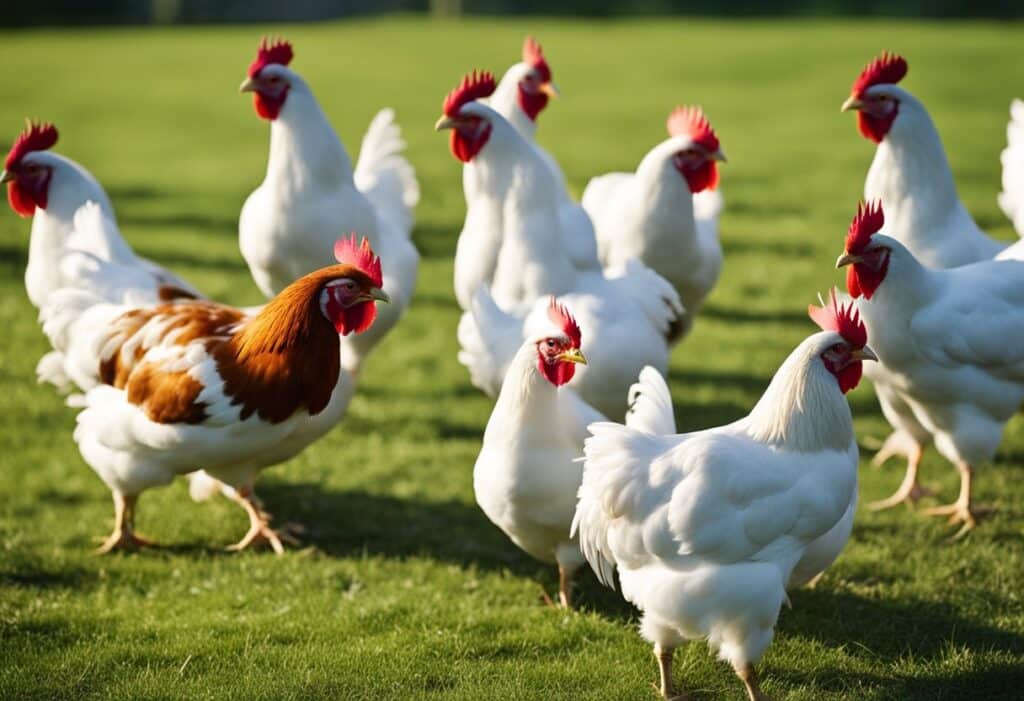
Leghorn chickens present a broad spectrum of varieties, particularly noticed in their plumage and comb types. Each variety has characteristics favored both in exhibitions and the egg production industry.
Color Variations
Leghorns are known for their diverse color patterns, which set them apart in appearance. Key color variations include:
- Black Leghorn: Exhibits a solid black plumage.
- Brown Leghorn: Features a rich brown color, with hens showing a lighter shade.
- Light Leghorn: Known for their white feathers, these birds are often utilized in commercial egg production.
- Red Leghorn: sports a deep red color.
- Buff Leghorn: Has a uniform golden-buff color across the body.
- Silver Leghorn: Their feathers are silver-white with distinct black markings.
- Dark Brown Leghorn: These birds have a darker, more intense brown shade than their lighter counterparts.
- Blue Leghorn: Their feathers are a slate blue color.
- Black-Tailed Red Leghorn: Combines a red body with a contrasting black tail.
- Columbian Leghorn: They are white with black neck, wing, and tail markings resembling the Columbian pattern.
- Exchequer Leghorn: They possess a distinctive checkered black and white pattern.
Comb Variations
In Leghorns, combs are prominent and come in different shapes, with two primary variations being widespread:
- Single Comb: This is the most common comb type, upright and with evenly spaced points.
- Rose Comb: These are more compact and lie close to the head, having a textured surface that resembles a rose.
The breed also includes other comb types, but these two are the most known and influential for breed standards and climate adaptability. Breeders often opt for the Rose Comb in colder climates to reduce the risk of frostbite.
Egg Production
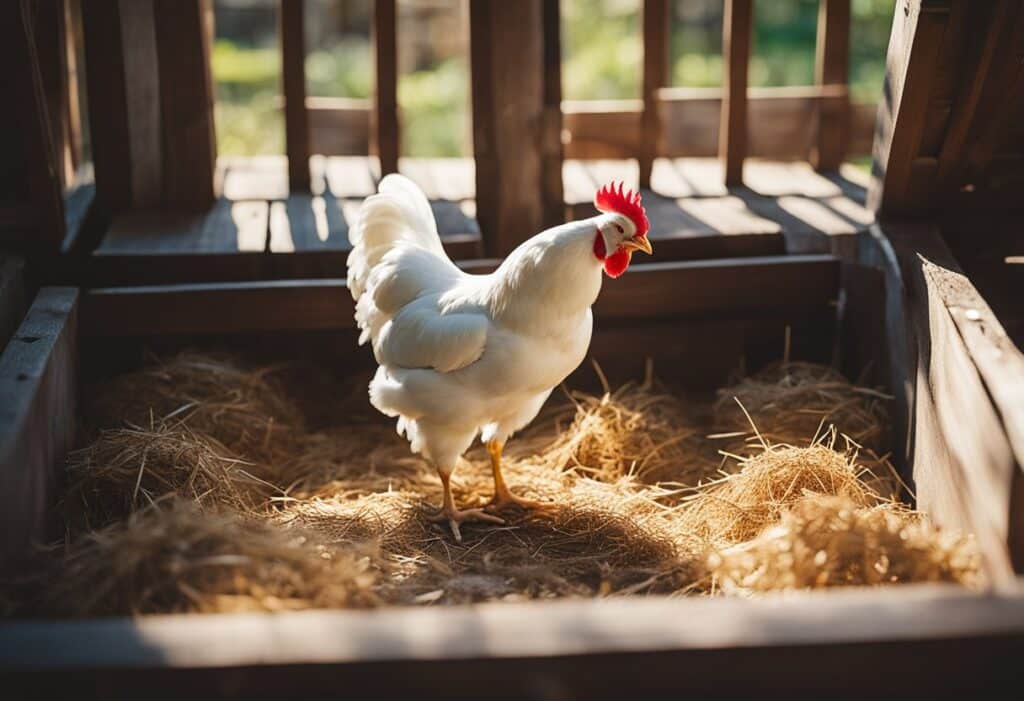
The Leghorn chicken is celebrated for its impressive egg-laying prowess and the distinctive white eggs it produces.
Egg-Laying Capacity
Leghorn chickens are among the most prolific egg layers in the poultry world. On average, a healthy Leghorn hen can lay between 280 to 320 eggs per year. They start laying eggs at around 16 to 17 weeks of age and continue with high productivity for several years. These birds are not typically broody, meaning they rarely sit on their eggs to hatch them, which contributes to their consistent egg-laying performance.
Egg Characteristics
The eggs of Leghorn chickens have several distinctive features. Firstly, they are uniformly white in color, a trait highly valued by certain markets. When it comes to size, the eggs are usually classified as large, which can be attributed to the hen’s selective breeding. The eggshell is known for its good strength, which reduces the chances of breakage during handling and transportation. While Leghorn hens lay plentifully, their nurturing instinct is low, so they are less likely to become broody and interrupt their egg-laying cycle for hatching chicks.
Care and Management
The Leghorn chicken requires diligent care and management to ensure its health and productivity. They are a hardy breed that thrives on proper feeding, and their active nature demands ample space and regular maintenance.
Feeding and Nutrition
Feed: Leghorns are prolific layers and require a diet rich in protein to support consistent egg production. A balanced layer feed should be offered, containing approximately 16-18% protein. It is advisable to provide a mix of pellets, grains, and supplemental calcium, such as oyster shells, for strong eggshells.
Foraging: This breed also benefits from access to forage. Allowing them to scratch and peck in a secure outdoor area can supplement their diet with insects and vegetation, which also promotes natural behaviors and exercise.
Health and Maintenance
Health Issues: Leghorns are generally robust but can be susceptible to common poultry ailments such as respiratory issues or parasites. Regular health checks are necessary to spot early signs of illness. Vaccinations and preventive measures should be part of their health care routine.
Confinement and Space: While Leghorns are adaptable to confinement, they are lively birds and do best with ample space to roam. In terms of space, a minimum of 3-4 square feet per bird within the coop and 8-10 square feet in an outdoor run is recommended. Proper space helps reduce stress, which is vital for maintaining health and minimizing aggressive behaviors.
Predators: A secure environment is critical to protect Leghorns from potential predators. The coop and run must be constructed to prevent access by predators, with considerations such as buried hardware cloth, sturdy locks, and covered runs.
Maintenance: Regular coop cleaning is essential to prevent disease. Remove droppings and wet bedding promptly, and provide fresh, clean water daily. The cost of maintenance should be planned for, as it includes feed, health care, and potential repairs to enclosures to keep them predator-proof and safe for your backyard flock.
Adherence to the breed standard for care is also important for those who aim to show their birds or maintain the purity of the Leghorn breed.
Behavioral Traits
Leghorn chickens are known for their active temperament and distinctive social interactions. They exhibit specific behaviors that reflect their personality traits as a breed.
Social Behavior
Leghorns exhibit a sociable yet independent attitude within a flock. They are:
- Active breed: Continuously on the move, foraging extensively, demonstrating robust energy levels.
- Less broody: Hens infrequently exhibit broodiness, focusing more on egg-laying than nurturing chicks.
Cockerels and roosters maintain a hierarchical structure, often engaging in displays of dominance to assert their position.
Interaction with Predators
Leghorn chickens react to predators with heightened awareness and rapid response:
| Behavior | Description |
|---|---|
| Vigilance | They are alert and quick to notice potential threats. |
| Flighty nature | When threatened, they are prone to flight to evade predators. |
Roosters and cockerels may show aggression to protect the flock, using vocalizations to warn of danger. Despite their size, bantams also employ these protective strategies.
Utilization in Agriculture
The Leghorn chicken breed is integral to the agricultural sector, particularly in the domains of egg farming and backyard poultry keeping. Their roles are distinct, showcasing their adaptability and economic value in various settings.
Egg Farming
Leghorn chickens reign as one of the most prolific egg layers in commercial and industrial settings. Their capacity for high-volume production, especially during the winter months, makes them a mainstay in egg production industries. Industry data indicates that a single Leghorn can lay approximately 280 to 320 eggs per year.
| Age to First Egg | Average Annual Egg Count | Shell Color |
|---|---|---|
| 16-18 weeks | 280-320 | White |
These birds are prized for their consistent egg size and quality, maintaining steady output even when daylight diminishes during winter.
Backyard Poultry Keeping
In smaller-scale operations, like backyard poultry keeping, Leghorns serve as a dual-purpose breed. While they are predominantly chosen for their egg-laying prowess, they are also valued for their heritage and active disposition. The Leghorn chicken requires minimal space and upkeep, making them suitable for non-commercial keepers. They are characterized by their:
- Resilience to varying climates
- Foraging efficiency
- Minimal feed-to-egg conversion ratio
These factors contribute to the Leghorn’s status as a preferred choice among those maintaining a small number of poultry for personal egg production.
Adaptation to Environments
Leghorns have been remarkably adaptable, thriving in diverse environments found across their range of habitation. This trait is of particular importance for conservation, as it allows the breed to flourish in various climates and settings. In Britain, the adaptability of Leghorns has contributed to their popularity among poultry keepers, allowing the breed to thrive even in less than ideal weather conditions. Similarly, within North America, Leghorns are acclaimed for their ability to adjust to the climate variability they encounter, which ranges from the cold northern climates to the warmer southern regions. Their resilience and capacity to adjust to different spaces play a role in their continued breeding and conservation.
- Adaptation Highlights for Leghorn Chickens
- Proven ability to adapt and thrive in varied climates across North America and Britain.
- Leghorns’ versatility contributes to their popularity and suitability for different living conditions.
Global Distribution and Adaptation
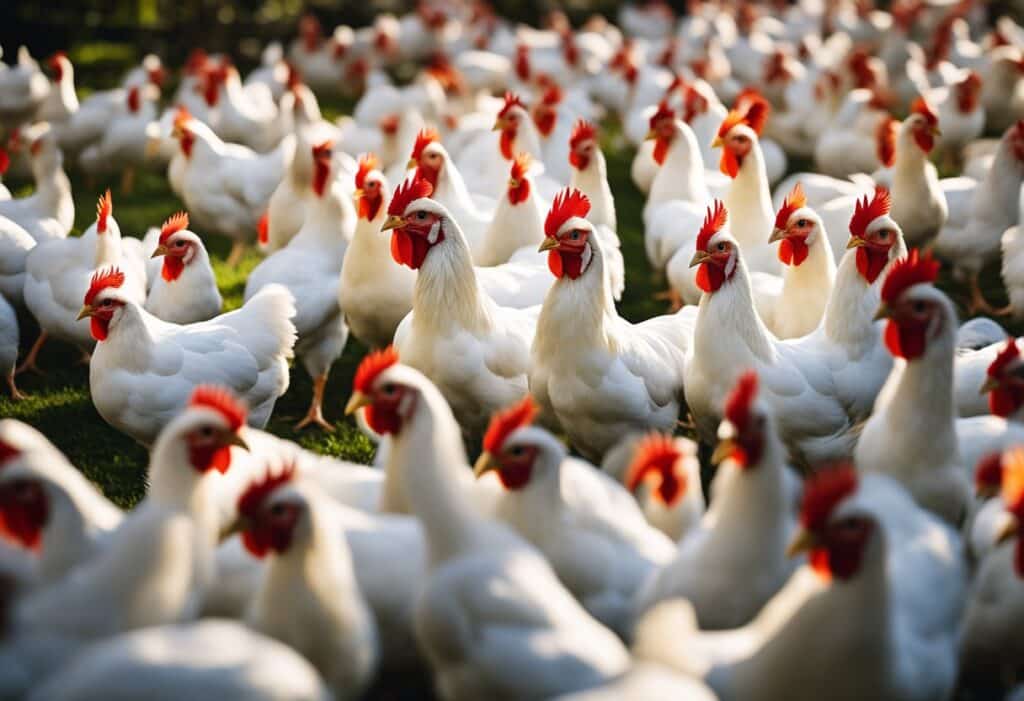
The Leghorn chicken is a prolific layer with a global footprint, known for its adaptability to various climates and its significant presence in North America’s rural areas.
Presence in North America
In North America, the Leghorn chicken has become a staple in rural poultry farming due to its high egg production and hardy nature. The breed is extensively used in commercial egg production, with the United States recognizing both white and brown Leghorns.
- United States: Large-scale commercial production and backyard flocks.
- Canada: Adapted to varying climates, from British Columbia to Quebec.
Leghorns have spread across the continent, thriving in differing environments from the cold northern regions to the more temperate zones.
Adaptation to Different Climates
Leghorns originate from the Mediterranean climate of Italy and have adapted well to both similar and varied climates around the world.
- Heat tolerance: Their Mediterranean roots contribute to their ability to withstand hot and dry conditions.
- Cold tolerance: Selective breeding in North America has enhanced their resistance to colder climates.
This breed’s adaptability is evident in their capability to maintain high egg production rates under a variety of environmental conditions. Leghorns have slender bodies with large combs and wattles, which, while perfect for heat dissipation in Mediterranean climates, require protection in colder areas to prevent frostbite.
Commercial and Economic Aspects
Contribution to the Egg Industry
Leghorn chickens are a cornerstone in the egg industry, chiefly due to their high egg-laying capacity. The average Leghorn hen is known to lay approximately 280 to 300 white eggs per year. The industrial-scale farming of Leghorns is a testament to their efficiency, contributing greatly to the stability and growth of the commercial egg sector.
- Egg Weight: 53-63 grams
- Age at first egg: around 16-18 weeks
- Peak production: around 90-95%
Role in Meat Production
In meat production, the Leghorn’s role is typically more niche compared to breeds like the Broiler. However, their fast maturity and good feed-to-meat conversion ratio make them suitable for the commercial meat industry, especially in sustainable and free-range settings.
- Average weight at maturity:
- Male: 3.4 to 4.1 kg
- Female: 2.3 to 2.7 kg
- Feed Conversion Ratio (FCR): Approximately 2.0-2.2 kg of feed per kg of meat
Leghorns have contributed to the diversification of the poultry meat market, although their prominence is primarily within the egg sector.
Leghorn Chicken in Modern Farming
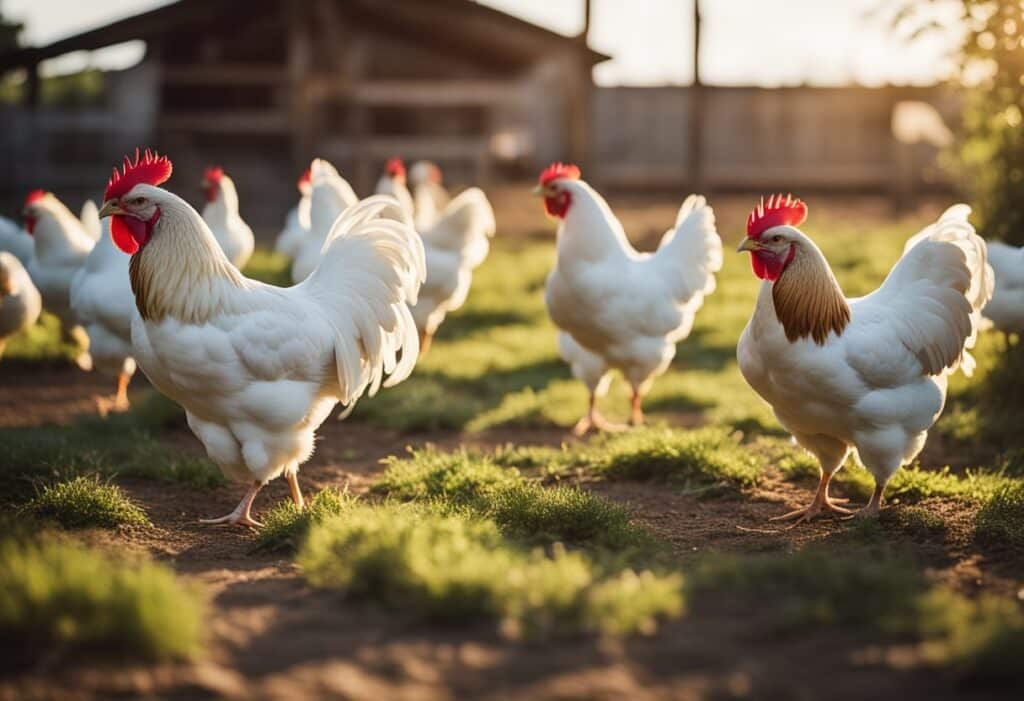
Leghorn chickens are a mainstay in modern farming due to their exceptional egg-laying capacity and adaptability to confinement. These birds are highly valued as livestock, laying up to 280 – 320 white eggs per year. They have become synonymous with commercial egg production.
Characteristics in Modern Systems:
- Egg Production: Prolific layers, essential for egg farming economy.
- Temperament: Known for their active, forager instincts despite confinement.
- Adaptability: Thrive in both free-range and confined environments.
Leghorns maintain a level of independence and foraging behavior, even in confined spaces, which contributes to their resilience in various farming setups. Farmers appreciate their hardiness and their ability to produce a high volume of eggs with relatively low feed intake, making them an efficient choice for poultry farming.
Modern farming advancements have made it easier to manage Leghorns in large flocks. The use of automated feeding and watering systems has streamlined the care process, allowing for greater focus on the health and welfare of the chickens.
Despite the tendency towards confinement in large-scale operations, there’s a growing interest in allowing Leghorns outdoor access. This aligns with consumer preferences for ethically produced eggs and the chickens’ natural inclination to forage. Hence, modern farms often strike a balance, providing Leghorn chickens with space to exhibit natural behaviors while optimizing production.
In summary, Leghorn chickens are integral to modern farming, embodying the shift towards efficient, high-output agriculture while demonstrating adaptability to evolving animal welfare standards.
Anatomy and Physiology
The Leghorn chicken, known for its distinctive physical features and reliable egg production, exhibits unique characteristics in both feather structure and reproductive physiology.
Feather Structure
Leghorn chickens possess a dense plumage that is predominantly white, although other color variations exist, such as black, red, and buff. The feathers are tight to the body, providing insulation and waterproofing. Notably, their feathers are:
- Primary feathers: Long and robust, aiding in flight.
- Secondary feathers: Shorter and provide insulation.
- Contour feathers: These outline the body and help maintain aerodynamics.
Reproductive System
The reproductive system of Leghorn hens has evolved for high egg production, with an average of 280 eggs per year. The hens are less likely to exhibit broodiness, a trait selectively bred out to optimize laying frequency. Key aspects include:
- Ovaries and Oviduct: Only the left ovary and oviduct are functional.
- Laying cycle: Each cycle spans approximately 24-26 hours.
- Egg characteristics: Eggs are white-shelled and of a consistent size.
Automatic mechanisms regulate their reproductive cycle, influenced by external factors such as daylight, ensuring a steady egg production throughout the year.
Breed Standards and Classification
The Leghorn chicken is a breed celebrated for its prolific egg laying abilities. Recognized by its distinctive full tail, erect stance, and long, flowing tail feathers, the Leghorn chicken conforms to defined breed standards.
American Poultry Association (APA) standards are integral to Leghorn classification. The APA documents these standards within the seminal American Standard of Perfection. It outlines specific requirements for body type, weight, and feathering. Leghorn chickens are categorized into large fowl and bantam varieties.
The breed standards specify the following for large fowl Leghorns:
- Weight: Males 3.4 kg (7.5 lbs), Females 2.5 kg (5.5 lbs)
- Comb Type: Single or rose comb
- Egg Color: White
In Britain, The Poultry Club of Great Britain oversees the standards for Leghorn chickens, which are similar but may have slight differences compared to the APA’s standards.
Listed below are key features for Leghorn chickens as per the breed standards:
- Color Varieties: Includes white, black, blue, buff, and more.
- Leg Color: Yellow
- Earlobe Color: White
- Skin Color: Yellow
These exacting standards ensure consistency within the breed, whether for showing, breeding, or agricultural purposes. Adherence to these classifications reinforces the integrity of the Leghorn lineage.
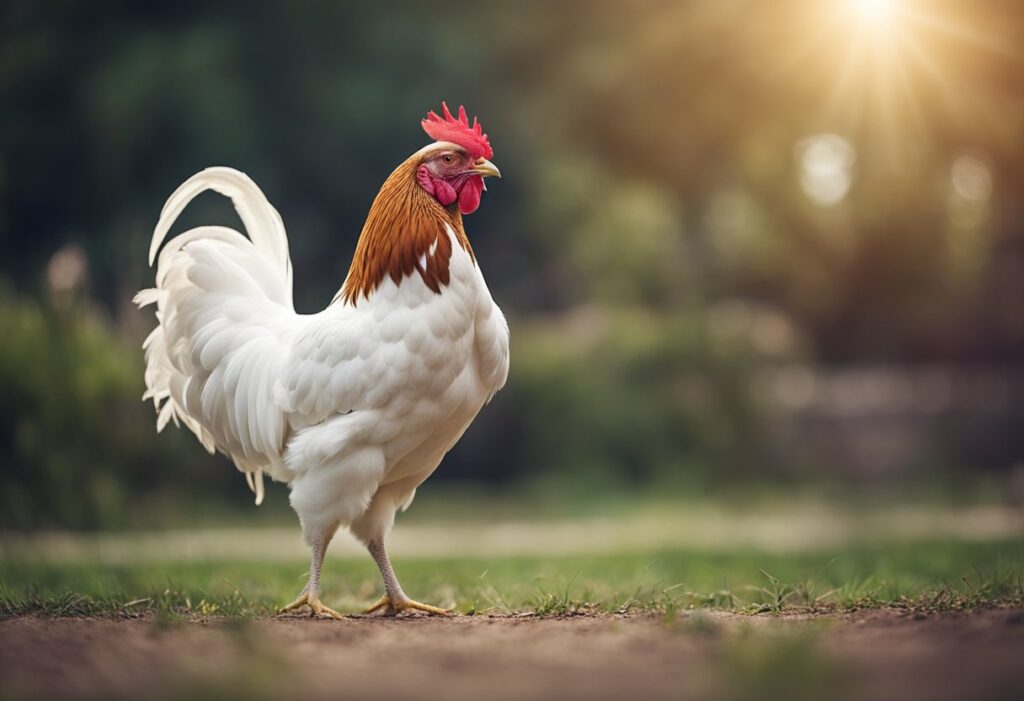
Lifespan and Longevity
The Leghorn chicken is a hardy breed known for its impressive longevity. On average, these birds have a lifespan ranging from 5 to 10 years, although they can occasionally live longer with optimal care. The lifespan of a Leghorn is influenced by several factors including genetics, environment, and the quality of care they receive.
Key Factors Affecting Lifespan:
- Genetics: The breed’s natural hardiness contributes to their longer lifespan.
- Environment: Adequate shelter, space, and a safe environment can increase longevity.
- Care: Providing a balanced diet, clean water, and regular health check-ups can help maximize a Leghorn’s lifespan.
Leghorns are robust layers, often beginning egg production earlier than many other breeds. Although their egg-laying prowess generally declines as they age, their overall health can remain strong throughout their lives with proper management.
In order to ensure a long and healthy life for Leghorn chickens, owners are advised to:
- Provide proper nutrition tailored to the chicken’s age.
- Maintain a clean and stress-free living environment.
- Protect against potential predators and disease.
Regular veterinary care should also be sought to prevent and address any health issues that may arise. Vaccinations and parasite control will help reduce the risk of illness, further promoting longevity in this breed. By tending to these aspects of care, owners can help their Leghorn chickens achieve a full and vibrant life.
Nutrition and Feed Efficiency
Leghorn chickens are renowned for their remarkable feed efficiency, making them a highly economical choice for egg producers. They require a balanced diet that provides adequate nutrition to maintain their prolific egg-laying capacities.
Daily Feed Intake: An adult Leghorn typically consumes about 1/4 pound of feed per day. The feed should be rich in protein, as they require approximately 16-18% protein in their diet to sustain optimal egg production.
Feed Composition:
- Proteins: Essential for growth and egg production.
- Carbohydrates: Major energy source.
- Fats: Concentrated energy and essential fatty acids.
- Vitamins and Minerals: For overall health and shell quality.
Forage: In addition to their feed, Leghorns benefit from access to forage. This can include:
- Grasses
- Insects
- Seeds
- Grains
Foraging naturally complements their diet with essential nutrients and aids digestive health.
Egg Yolk Color: Feed ingredients that contain xanthophylls, such as corn and alfalfa, contribute to the yellow pigment in egg yolks. Though the color does not affect nutritional value, consumer preference often leans towards a darker yellow yolk.
To sum up, a balanced diet with properly formulated feed and access to forage is essential for sustaining the Leghorn’s health and high egg-laying performance. The yellow yolk of their eggs can be enhanced through the addition of specific ingredients to their diet. Efficient feed conversion and a nutritious diet secure Leghorns as a favorite in the poultry industry.
Genetics and Breeding Programs
Leghorn chickens possess a rich genetic background that significantly contributes to their widespread use in breeding programs. Their genetic make-up is responsible for their exceptional egg-laying capabilities and resilience, making them a prime choice for poultry farmers focused on egg production.
Breeding programs have capitalized on these genetics to enhance specific traits. Notable among these traits are:
- Egg size: Selective breeding has focused on increasing the size of the eggs produced by Leghorn chickens.
- Color Varieties: Through genetic selection, a diverse palette of feather colors is available, ranging from white to black, red, and more.
- Production efficiency: Breeding efforts aim to produce birds that convert feed into eggs as efficiently as possible.
The table below outlines key aspects of Leghorn chicken genetics:
| Trait | Significance in Breeding Programs |
|---|---|
| Egg color | White eggs are most common and a primary selection trait. |
| Egg size | Larger eggs are favored, selection for increased size is ongoing. |
| Color | Various colors are maintained and developed through breeding. |
Breeding programs follow rigorous selection criteria to ensure the propagation of desirable characteristics. Geneticists and breeders often work in conjunction to exchange best practices and make informed decisions on breeding pairs.
In terms of breeding considerations, one must underscore the importance of managing genetic diversity. Maintaining a broad genetic base is crucial to prevent inbreeding depression, which can lead to reduced vitality and production inefficiencies.
The interplay between genetics and breeding programs forms the backbone of the Leghorn chicken’s success as a prolific layer in the poultry industry. Continuous improvement and adaptations are key to meeting the evolving demands of egg producers and the market.
Pullet and Cockerel Development
Leghorn chickens, recognized for their prolific egg-laying abilities, exhibit distinctive development phases for pullets (young hens) and cockerels (young roosters).
During the first few weeks, both pullets and cockerels experience rapid growth and will almost double in size. It’s essential to provide a high-protein starter feed to sustain this growth pace.
Feather Development:
- By Week 3: Primary feathers are well-formed.
- By Week 5: Feathering starts differentiating sexes; pullets have more evenly patterned plumage.
Physical Growth Milestones:
| Age | Pullet Development | Cockerel Development |
|---|---|---|
| 6-8 weeks | Pullets show growing feathers; lighter body weight. | Cockerels are larger with pronounced combs and wattles. |
| 8-12 weeks | Growth rate slows; pullets continue feather development. | Cockerels begin crowing; aggressive play may ensue. |
| 12-20 weeks | Puberty is approaching; pullets may begin squatting. | Cockerels distinctively larger with longer crowing. |
The onset of puberty in pullets is marked by their readiness to lay eggs, typically achieved by 18 to 22 weeks. Pullets will have a developed comb and wattles, which are often bright red, signaling maturity.
Cockerels, on the other hand, may exhibit early signs of crowing behavior as early as 8 weeks but typically establish their full crowing routine closer to 12 weeks. The maturity of cockerels is also visible in their more assertive behavior and the development of hackle and saddle feathers, which are longer and more pointed than those of the pullets.
It is important to provide adequate nutrition tailored to each developmental stage to ensure healthy growth for both pullets and cockerels. Proper care and attention to these developmental milestones are essential for raising Leghorn chickens successfully.
Impact on Local Ecosystems
The introduction of Leghorn chickens into local ecosystems has observable effects on various levels. These chickens, primarily raised for egg production, often become part of backyard flocks. In such environments, they fulfill a role as foragers. They actively search for and consume a range of insects and plants, which may lead to reduced pest populations.
Predators: The presence of these domesticated birds can attract native and non-native predators to an area. Common threats to backyard flocks include:
- Raptors (hawks, eagles)
- Carnivorous mammals (foxes, raccoons)
- Reptiles (snakes)
Agricultural landscapes can experience changes in predator behavior and populations, as these animals may alter their hunting patterns to target easy prey like domesticated Leghorn chickens.
Foraging Behavior: The impact of foraging on the ecosystem can be both beneficial and detrimental. Leghorns, known for their active foraging, can help control insect populations, potentially reducing the need for chemical pest control. However, their foraging can also lead to:
- Degradation of localized flora
- Disruption of seed distribution
- Soil compaction
Backyard Flocks and Biodiversity: The integration of Leghorn chickens into backyard flocks may influence local biodiversity. They compete with native species for food resources and may spread non-native plant seeds through their droppings.
Mitigating Negative Impacts: Responsible management of backyard flocks is crucial. Measures include:
- Secure enclosures to protect chickens from predators and limit wild animal disruptions
- Controlled ranging to minimize environmental damage
- Balanced feeding practices to avoid excessive dependency on local flora and fauna
Careful planning and management are essential to ensure that the addition of Leghorn chickens to local ecosystems is sustainable and does not disrupt the natural balance.
Comparison with Similar Breeds
Leghorn chickens, known for their prolific egg-laying abilities, often find themselves compared to other breeds, particularly those of Mediterranean origin such as the Minorca.
Size & Appearance: In contrast to larger Minorcas, Leghorns are relatively smaller birds. Both breeds share a common heritage, exhibiting glossy feathers and a sleek profile. However, Leghorns have a distinctive, erect single or rose comb, while the Minorca displays a larger single comb, which can be prone to frostbite in colder climates.
Egg Production: Leghorns are excellent layers, typically outperforming Minorcas by laying an impressive number of white eggs. Minorcas lay fewer, but larger, white eggs and are appreciated for the quality rather than quantity.
Temperament: Leghorns are active and can be flighty, requiring more space to roam. They are known for their hardiness. In contrast, Minorcas are known to be more docile but still enjoy foraging if given the opportunity.
Climate Resilience: Both Leghorn and Minorca chickens adapt well to heat, characteristic of their Mediterranean roots. However, Leghorns, with their smaller combs, are more resistant to cold weather than the larger-combed Minorcas.
Conservation Status: While Leghorns are common and not considered a heritage breed, the Minorca, with its declining numbers, is often classified as a heritage breed and can benefit from conservation efforts.
| Trait | Leghorn | Minorca |
|---|---|---|
| Size | Smaller | Larger |
| Egg Production | Higher | Lower |
| Egg Size | Smaller | Larger |
| Temperament | Active / Flighty | Docile |
| Climate Resilience | Better in cold | Better in heat |
| Conservation Status | Not heritage | Heritage breed |
Leghorn Chicken as Pets
Leghorn chickens are a popular choice for those looking to maintain backyard flocks due to their hardy nature and consistent egg production. They are particularly renowned for their prolific laying abilities, with the potential to produce approximately 250 to 300 large white eggs annually.
Personality Traits:
- Active: Leghorns are known for their high activity levels, making them entertaining companions.
- Independent: They are relatively self-sufficient and do well in environments where they can forage.
- Alert: These birds are vigilant, which can be beneficial for pest control.
Considerations for Keeping Leghorns:
- Space: They thrive in environments where they have ample space to explore and exercise.
- Social Structure: It is advisable to keep them in groups, as chickens are social animals and Leghorns are no exception.
When integrating Leghorns into a backyard flock, it’s important to note that their active behavior and alertness can influence the flock dynamics. Prospective owners should ensure a secure and spacious coop to accommodate their foraging instincts and energetic disposition.
Health and Care:
- Diet: A balanced diet is crucial; Leghorns need a mix of quality feed, fresh vegetables, and occasional protein sources.
- Preventive Healthcare: Regular veterinary check-ups and vaccinations are recommended to keep them in optimal health.
In summary, while Leghorns may not be as affectionate as other breeds, their independent streak and efficient egg production make them a pleasing choice for owners who can cater to an active breed’s needs. For the family seeking a practical pet that also contributes to the household, Leghorns stand out as a robust option.
Potential Challenges and Solutions
Leghorn chickens are robust birds, but they do face certain challenges that owners need to be aware of:
Health Issues: Respiratory problems, parasites, and egg binding are notable health issues in Leghorns.
- Solution: Regular check-ups, vaccinations, and maintaining clean coops can reduce health risks. Deworming and parasite control measures are essential.
Predators: Hawks, foxes, and raccoons pose a threat to safety.
- Solution: Secure housing, such as fencing, and covered runs help protect them from aerial and ground predators.
Breed Standard: Maintaining the Leghorn’s distinctive appearance may be difficult.
- Solution: Selective breeding and adherence to breed standards are crucial for preserving the desired characteristics.
Space Requirements: They are active foragers requiring ample space.
| Solution | Details |
|---|---|
| Adequate Space | Provide at least 4 square feet per bird in the coop and 8-10 square feet in the run. |
| Enrichment | Offer perches, dust baths, and areas for foraging. |
Cost: The initial setup and ongoing costs can accumulate.
- Solution: Budget effectively for housing, food, healthcare, and emergency expenses. Investing in quality feed and coops can save money in the long run.
When addressing these challenges with proactive measures, Leghorn chickens can thrive and be productive members of a flock.


